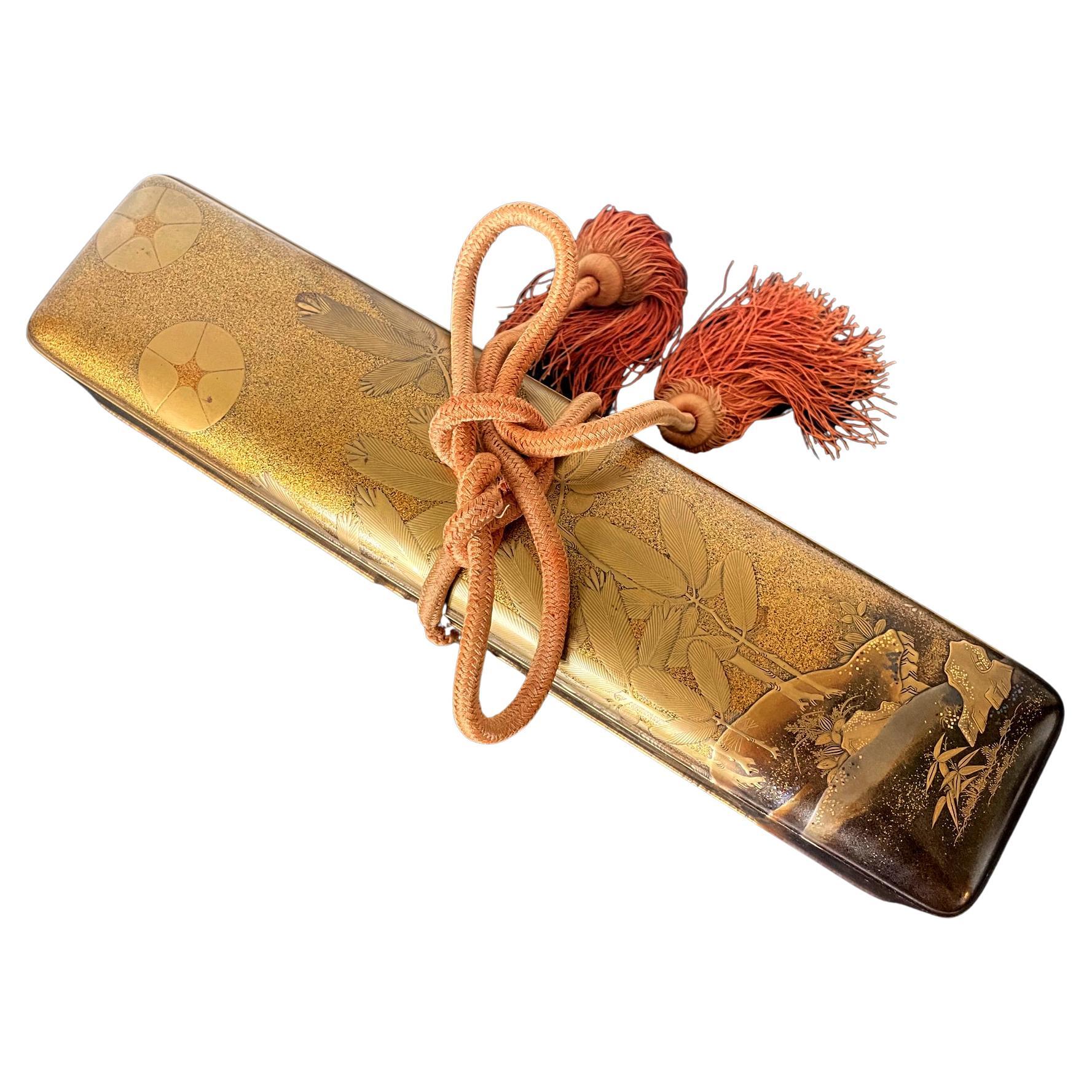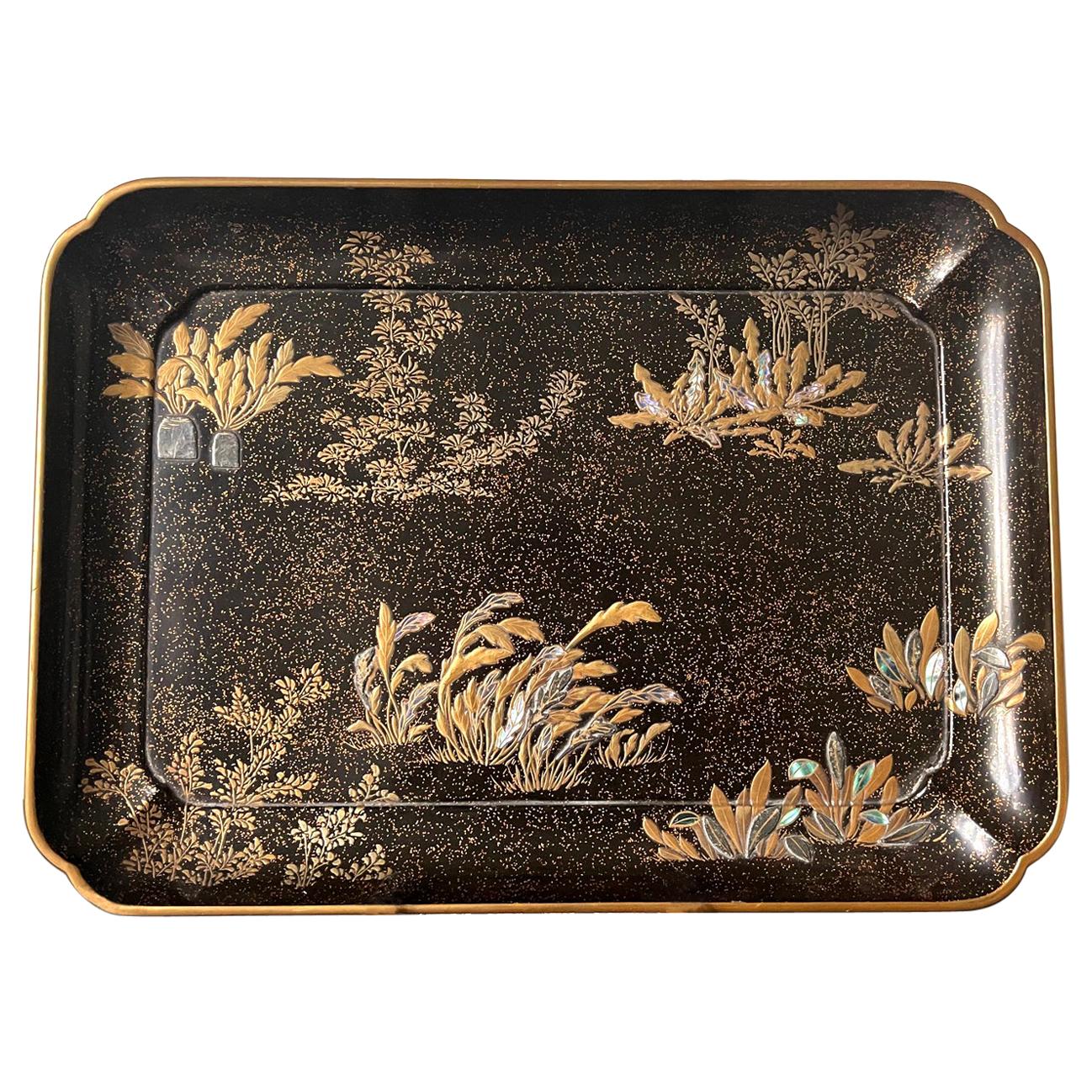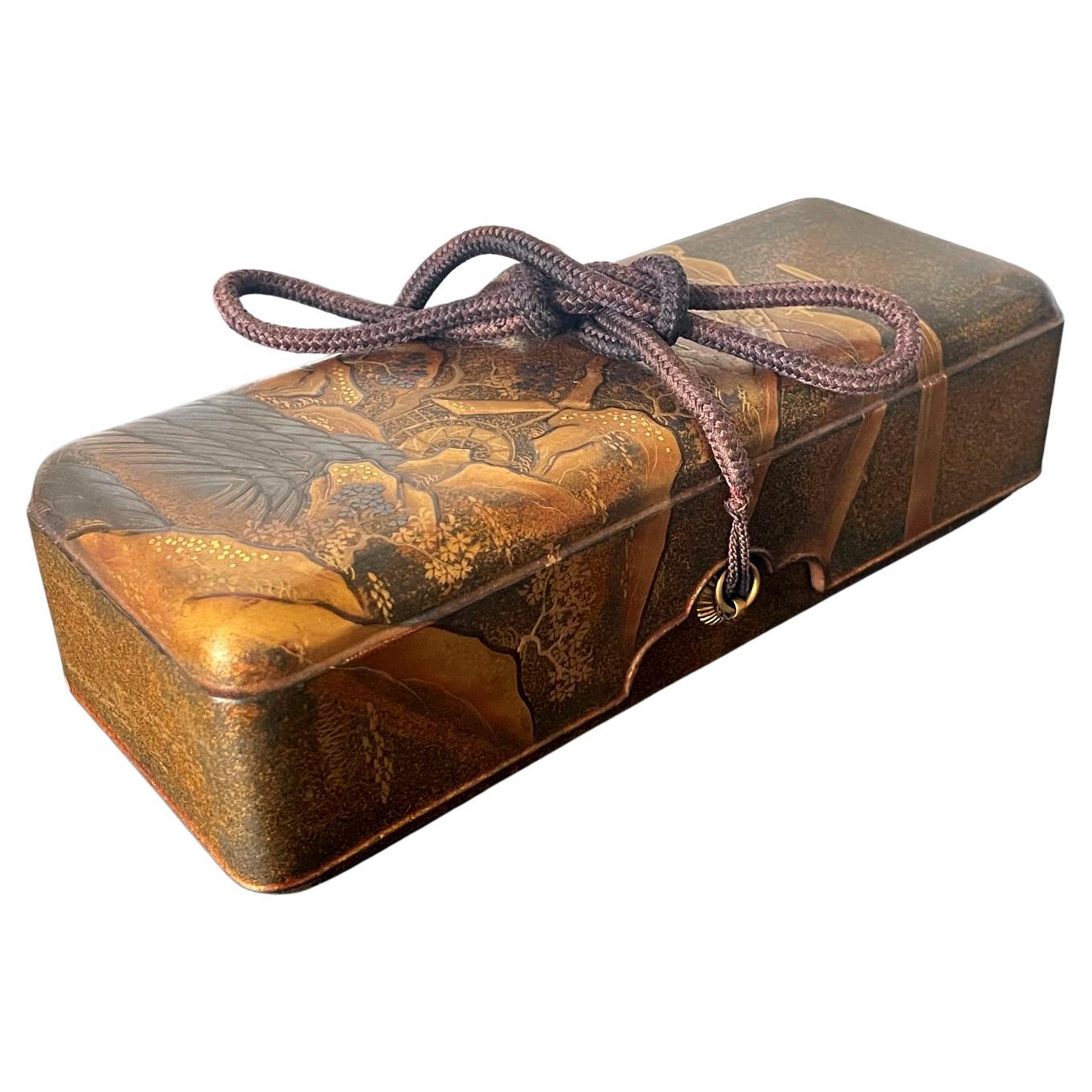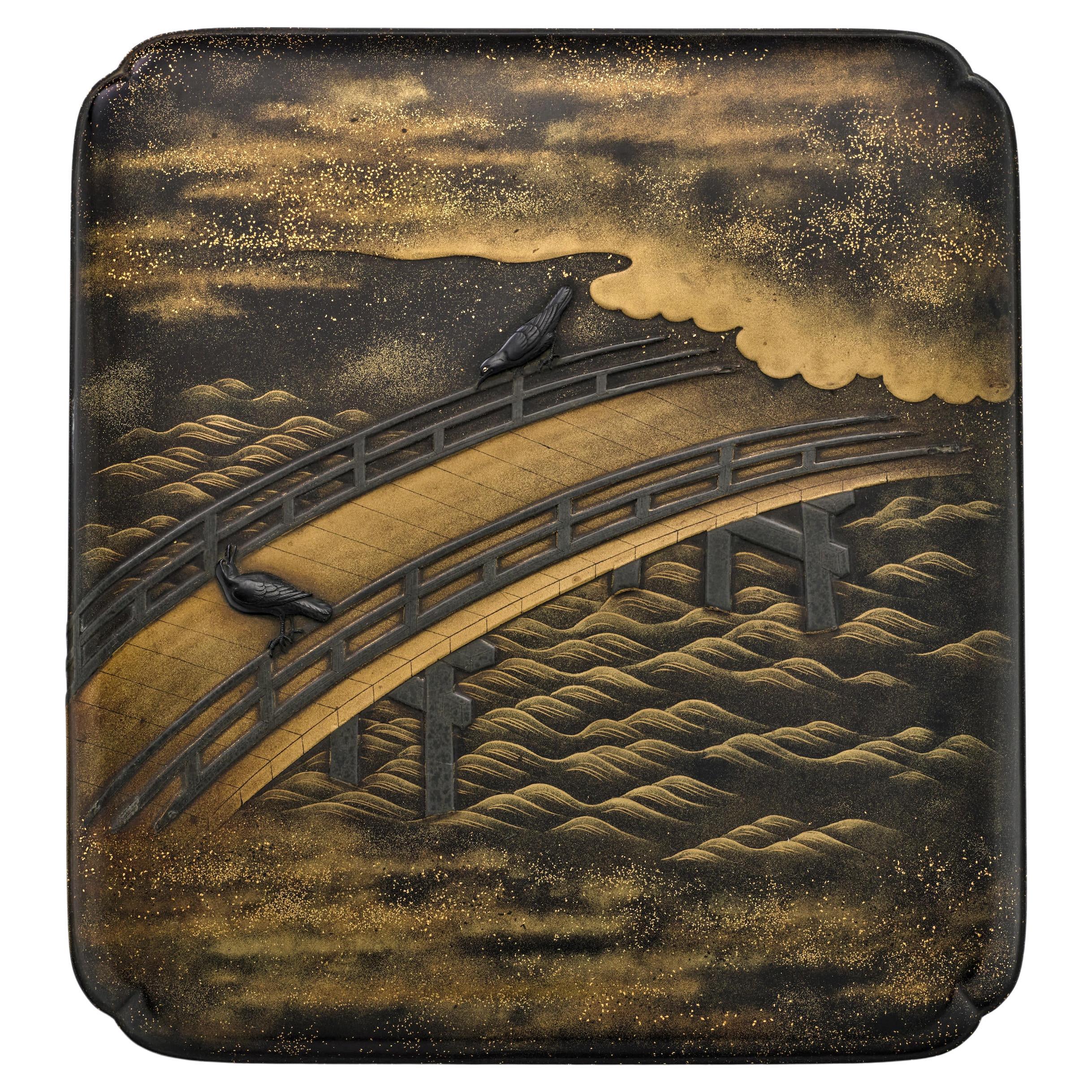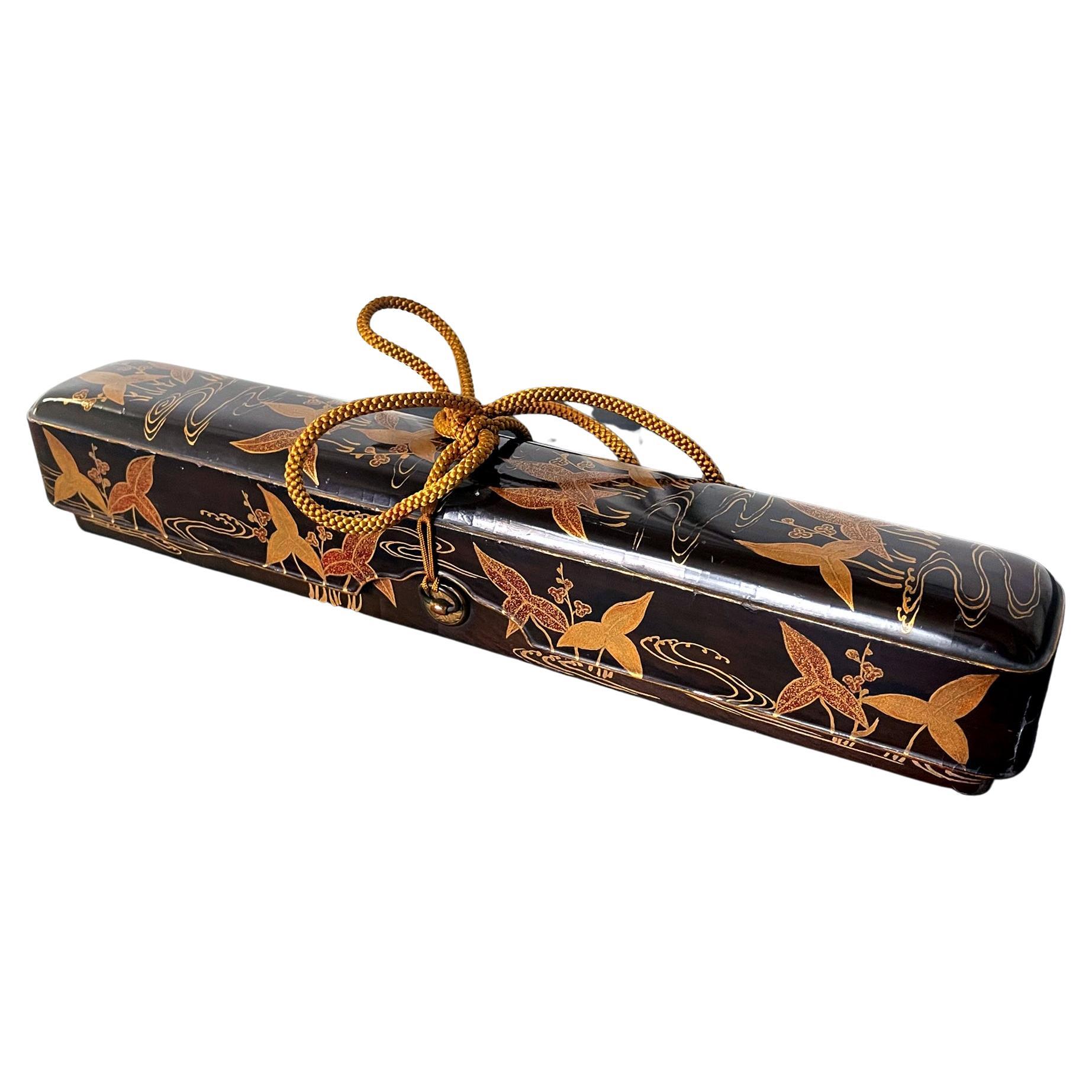Items Similar to Japanese Meiji Han Koto with Maki-e Lacquer Decoration
Want more images or videos?
Request additional images or videos from the seller
1 of 11
Japanese Meiji Han Koto with Maki-e Lacquer Decoration
About the Item
A rare Japanese Koto made from carved Paulownia wood and lavishly decorated with lacquer Maki-e circa late 19th century of Meiji Period (1868-1912). The facade of the stringed instrument features beautiful gold takamaki-e and hiramaki-e decoration. The image showcases a pair of peacocks with splendid plumage perched on rocks by a stream among flowering peonies below flying butterflies. Radan (mother-of-pearl) inlays were used to highlight the tails feathers of the peacock. The ends of koro are decorated with chrysanthemum blossoms inlaid with jade colored hardstone.
For similar koto dated in the collection of the Metropolitan Museum of Art, see accession number 69.271.3.
The Koto is considered the national instrument of Japan. It originated from the Chinese Guzheng but developed its own tradition in Japan since the 8th century. It was traditionally played as a form of entertainment in the imperial courts. Traditionally made of paulownia wood and set with thirteen strings played by being plucked with three fingerpicks, tsume, worn on the first three fingers of the right hand. The Koto presented here is meticulously and luxuriously detailed with auspicious decoration of peonies and peacocks which represent worldly power and wealth in Japanese culture. Therefore, this koto was likely created as a ceremonial gift, not meant to be played regularly but rather admired for its beauty and symbolism.
- Dimensions:Height: 55 in (139.7 cm)Width: 9 in (22.86 cm)Depth: 3.5 in (8.89 cm)
- Style:Japonisme (Of the Period)
- Materials and Techniques:Wood,Lacquered
- Place of Origin:
- Period:
- Date of Manufacture:Late 19th Century
- Condition:Wear consistent with age and use. Minor losses. The facade is in fine condition with a few small losses of MOP inlays. Old stable crack on one sides and bottom; some small surface losses to edge of the other side. Strings mostly intact, bridges not present. Wood losses on the base. Not playable.
- Seller Location:Atlanta, GA
- Reference Number:1stDibs: LU945030467262
About the Seller
5.0
Platinum Seller
These expertly vetted sellers are 1stDibs' most experienced sellers and are rated highest by our customers.
Established in 2006
1stDibs seller since 2010
479 sales on 1stDibs
Typical response time: <1 hour
- ShippingRetrieving quote...Ships From: Atlanta, GA
- Return PolicyA return for this item may be initiated within 2 days of delivery.
More From This SellerView All
- Japanese Lacquered Gold Maki-E Naga Fubako Meiji PeriodLocated in Atlanta, GAA Japanese lacquered wood Naga Fubako (a long box used to store document or large scroll painting), circa 19th century Meiji period. The rectangular box features an unusually deep lipped lid with slightly rounded corners, a conforming lower box with bronze medallion rings with tasseled...Category
Antique 19th Century Japanese Meiji Lacquer
MaterialsWood, Lacquer
- Japanese Lacquer Tray with Maki-e and Inlay Hara Yoyusai Edo PeriodLocated in Atlanta, GAA lovely Japanese lacquer rectangular lacquer tray with a slightly scalloped corner and four L shape supporting feet by one of the most celebrated lacquer artist active in Edo period Hara Yoyusai (1772-1845). Yoyusai lived in Edo (Tokyo) and worked under the patronage of Lord Matsudaira. He operated a large workshop and had a very prolific output of lacquer objects. Most survived pieces being inro...Category
Antique 19th Century Japanese Japonisme Lacquer
MaterialsWood, Lacquer
- Japanese Lacquered Maki-e Fubako Edo PeriodLocated in Atlanta, GAA Japanese lacquered wood fubako (a box used to store document or small scroll painting), circa second half of 19th century late Edo period. The rectangular box features an unusually deep lipped lid with slightly rounded corners, a conforming lower box that is almost entirely covered by the lid which has two bronze medallion rings with tasseled...Category
Antique 19th Century Japanese Edo Lacquer
MaterialsWood, Lacquer
- Exquisite Japanese Lacquer Maki-e Suzuribako by Koma Kyūhaku Edo PeriodLocated in Atlanta, GAOne of the finest Japanese Maki-e Suzuribakos (ink box) we have on offer, the roiro color box showcases an ambient nocturnal scene in which two shakudo inlaid crows perched on the handrails of a bridge (possible the Uji Bridge...Category
Antique Early 19th Century Japanese Japonisme Lacquer
MaterialsStone, Metal
- Japanese Lacquered Maki-E Fubako in Kodaiji StyleLocated in Atlanta, GAA rare Japanese lacquered wood fubako decorated in Kodaiji maki-e style circa early 17th century the beginning of the Edo period, possibly early toward the end of the Azuchi-Momoyama period. The rectangular, long and slim box features a deep lipped lid with slightly rounded corners, a conforming lower box with two bronze medallion rings with tasseled...Category
Antique Early 17th Century Japanese Edo Lacquer
MaterialsWood, Lacquer
- Japanese Lacquered Maki-E Natsume in Kodaiji StyleLocated in Atlanta, GAA Japanese lacquered tea caddy (known as Natsume) with fine Maki-e decoration circa 18-19th century Edo to Meiji period. The large-sized nat...Category
Antique 19th Century Japanese Meiji Lacquer
MaterialsWood, Lacquer
You May Also Like
- Japanese Lacquer Hibachi with Imperial Chrysanthemum, Meiji Period, JapanLocated in Austin, TXA simple and elegant Japanese lacquer hibachi stand with imperial chrysanthemum mon and copper liner, now modified as an usubata, late Meiji Period, ci...Category
Antique Early 1900s Lacquer
MaterialsCopper
- Japanese Meiji Period Antique Lacquer Box with Gold Maki-e DecorationLocated in New York, NYA fine antique Japanese Meji Period lacquer box decorated with a fan and a stylized star shaped window in the maki-e technique. The fan at the top right corner, fully opened depictin...Category
Antique 19th Century Japanese Meiji Lacquer
MaterialsLacquer
- A Japanese maki-è lacquer inroLocated in Milano, ITJapanese inro with two compartments, in maki-è lacquer with nashiji decorations and circular reserves depicting flowers and leaves. Coral colored ojime and lacquer manju netsuke. Si...Category
Antique Mid-19th Century Japanese Japonisme Lacquer
MaterialsLacquer
- Japanese Maki-e Lacquer Stacking Box, Jubako, Meiji Period, JapanLocated in Austin, TXA fine and impressive Japanese gold maki-e decorated black lacquer five-tier jubako with presentation tray, two lids, and the original tomobako storage box, Meiji period, late 19th c...Category
Antique Late 19th Century Japanese Meiji Lacquer
MaterialsLacquer
- Signed Japanese White Lacquer and Maki-E Lacquer Tansu, Meiji PeriodLocated in Ottawa, OntarioThe case decorated overall in crackle-glaze white lacquer and fitted with a patinated metal carrying handle over three tiers of small drawers. The first two tiers are comprised of a ...Category
Antique Late 19th Century Japanese Meiji Lacquer
MaterialsLacquer
- Japanese Edo Period Lacquer and Mother-of-Pearl Embellished Stoneware KoroLocated in Austin, TXA highly unusual Japanese crackle glazed koro (incense burner or censer), lacquered and inlaid with mother-of-pearl embellishment, signed Gyokusen, Ed...Category
Antique 19th Century Japanese Edo Scholar's Objects
MaterialsCopper
Recently Viewed
View AllMore Ways To Browse
Pair Lacquer
Pair Of Lacquer
E Pearl
Inlaid Lacquer
Lacquer Mother Of Pearl
Imperial Japan
Japanese Imperial
Japan China Set
Japanese Butterflies
Japanned Butterfly
Japanese Butterfly
Wood Entertainment
Antique Entertainment
Japanese China Set
Japanese China Sets
Pair Of Peacocks
Furniture With Hardstones
19th Pearl Inlaid Wood
